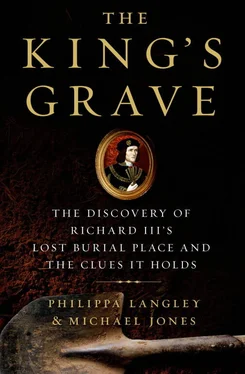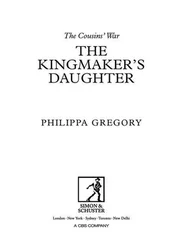We can find much common ground with figures from the medieval past, but in a number of important respects they were also very different from us. They had a far stronger collective sense of family and saw themselves as actors on this family stage, rather than individuals operating independently from it. Psychological profiling is a system that we in the twenty-first century can easily identify with – and it offers us a bridge to the past. Its values would be more alien to a medieval audience and we need to be aware of this.
Late medieval society operated under a different belief system to our own. It was a far more violent era, where life expectancy was shorter and much more fraught with risks. And yet it also had its own certainties: a way of seeing the world – whether through the lens of a Catholic religion yet to be challenged by the Reformation, or the warrior code of chivalry – that allowed an individual a sense of destiny and the possibility of redemption that we in our modern era would struggle to comprehend.
We ask the reader to remember this. And once again, the précis of the profile is not being offered as a replacement for a historical assessment of Richard’s life and death. However, it is hoped that its fresh frame of reference and insights will be stimulating and thought-provoking.
The following is a précis by a member of the Richard III Society of an article published in the Ricardian Bulletin in March 2013.
In 2011, as part of the Looking for Richard project, Philippa Langley commissioned two leading psychologists, one specializing in forensic psychology, to use their science in an experiment to see if we could learn anything new about Richard III and the kind of human being he really was.
They first explored one crucial issue: was he a murderous psychopath? For him to be so, he would be likely to exhibit a number of traits. The first of these is narcissism, a characteristic which manifests itself in extreme egotism combined with indifference to the feelings of others. Richard, however, appeared to be appropriate in his dress and was a natural leader of his people. Secondly there is cowardice, a quality conspicuous by its absence in the battles in which he fought. If Richard had displayed this characteristic, no doubt the Tudor historians would have seized upon it to denigrate him further. Machiavellianism, the use of cunning and duplicity in political dealings, was also considered. Richard’s open disapproval of his brother’s dealings with the French in 1475 was not in keeping with such an attitude. Finally, Richard’s interpersonal relationships were studied. A psychopath has no conscience in exploiting and manipulating people, yet Richard was able to form trusting and positive relationships.
A number of psychological approaches were then considered that might lead us to the ‘real’ Richard. In medieval times a physical disability might be seen as an outward manifestation of inner wickedness. The extent of Richard’s scoliosis was severe and, despite possible attempts at concealment, they conjectured that it was probably visible. Richard could have believed his condition was a failing within himself and therefore may have had feelings of guilt which could have made him defensive and behave with caution. He might have accepted it as the will of God; alternatively he could have felt rage and defiance, but Richard was known for his piety. His condition may have affected his dealings with others though, as we have already seen, he had no difficulty in forging strong relationships with others, a characteristic that continued during his reign as king.
Richard may have suffered from what is known in modern psychology as the ‘Intolerance of Uncertainty’ syndrome, an anxiety disorder characterized by excessive worry. He might have displayed some signs of this, perhaps most strongly seen in his sensitivity to possible threat and danger. Associated with this syndrome is extreme self-control which can lead to inflexible moral and religious beliefs.
The final part of the psychological analysis was an examination of Richard’s transition from Lord of the North to king. For a decade Richard had a clearly defined role in the north; he was his own man and got on with the job. Subsequently, the executions of Hastings and Buckingham could be seen as Richard’s need to assert control in an unfamiliar and rapidly changing situation.
In summary, we believe it was unlikely that Richard was a psychopathic murderer. Rather, the analysis shows him as a man with good and bad qualities, some attractive, some less so, perhaps including an excessive need or desire for control.
Five questions were then raised and speculative answers provided:
What does Hastings’s execution tell us? Although the nature of Hastings’s crime was not clear, it would have been entirely plausible for Richard to have acted with impetuosity if he believed that he had been betrayed. We see no inconsistency in the fact that he treated Hastings’s widow with respect.
Could Richard have murdered his nephews? No deposed medieval king of England subsequently survived for long. Richard may simply have followed in the footsteps of his predecessors. However, Richard had a claim to the throne of his own – one that he and others may have believed in – as a consequence of which his nephews were declared illegitimate. If this was true Richard did not necessarily have to kill the princes to succeed to the throne. Later, renewed threat of civil war may have forced his hand, obliging him to order their death; alternatively he may simply have resolved to move them to a safer location. As a cautious and judicious man we believe it was more in character for him to hide the princes than murder them.
Was he Machiavellian? We see Richard Imperilled to think and act by what he believed in. He was not a mere opportunist.
Did he take the throne opportunistically? Richard had a real sense of justice. Once the illegitimacy of the princes was raised as an issue, Richard may have felt that he was justified in staking his own claim to the throne. His record of loyalty to his brother Edward IV leads us to believe that he did not nurture a secret ambition to be king for years before his brother’s death.
Why did he die at Bosworth? At the battle’s climax Richard chose to make a dramatic charge against his opponent Henry Tudor. As an experienced soldier he probably believed this manoeuvre stood a good chance of success, and his belief in the legitimacy of his rule and his consciousness of being God’s anointed representative as monarch would have further motivated his action.
THIS BOOK HAS involved two parallel journeys: one about finding Richard III’s physical remains, the other around exploring his historical reputation. In the course of this, the authors would like to acknowledge the help and support they have received. These debts are many, and more specific instances of thanks are also given in the Notes.
* * *
Philippa Langley would like to start with an apology: for four years this search was my passion, and I am aware that I can’t possibly mention all those individuals without whom it would not have been possible. If your name is not recorded here, I ask your forgiveness.
I thank my co-author whose critically acclaimed Bosworth 1485: Psychology of a Battle re-ignited my quest for the real Richard III and led to my 2004 visit to a car park in Leicester. I had two wingmen at the 2012 dig, firstly Dr John Ashdown-Hill. His long years of painstaking research guided all our efforts, and everyone involved in this project is deeply indebted to him. Annette Carson, my other support, was the first writer I encountered who stated her belief that Richard III still lay where we found him. Her study of the contemporary sources propelled the search for the real Richard. Two founding members of the project, Dr David and Wendy Johnson, contributed unstinting commitment plus years of research to crucial tasks including the design of the tomb and formulating the Reburial Document. Dr Phil Stone, Chairman of the Richard III Society, personally saved the project on four separate occasions, demonstrating belief and vision of truly Ricardian proportions.
Читать дальше












